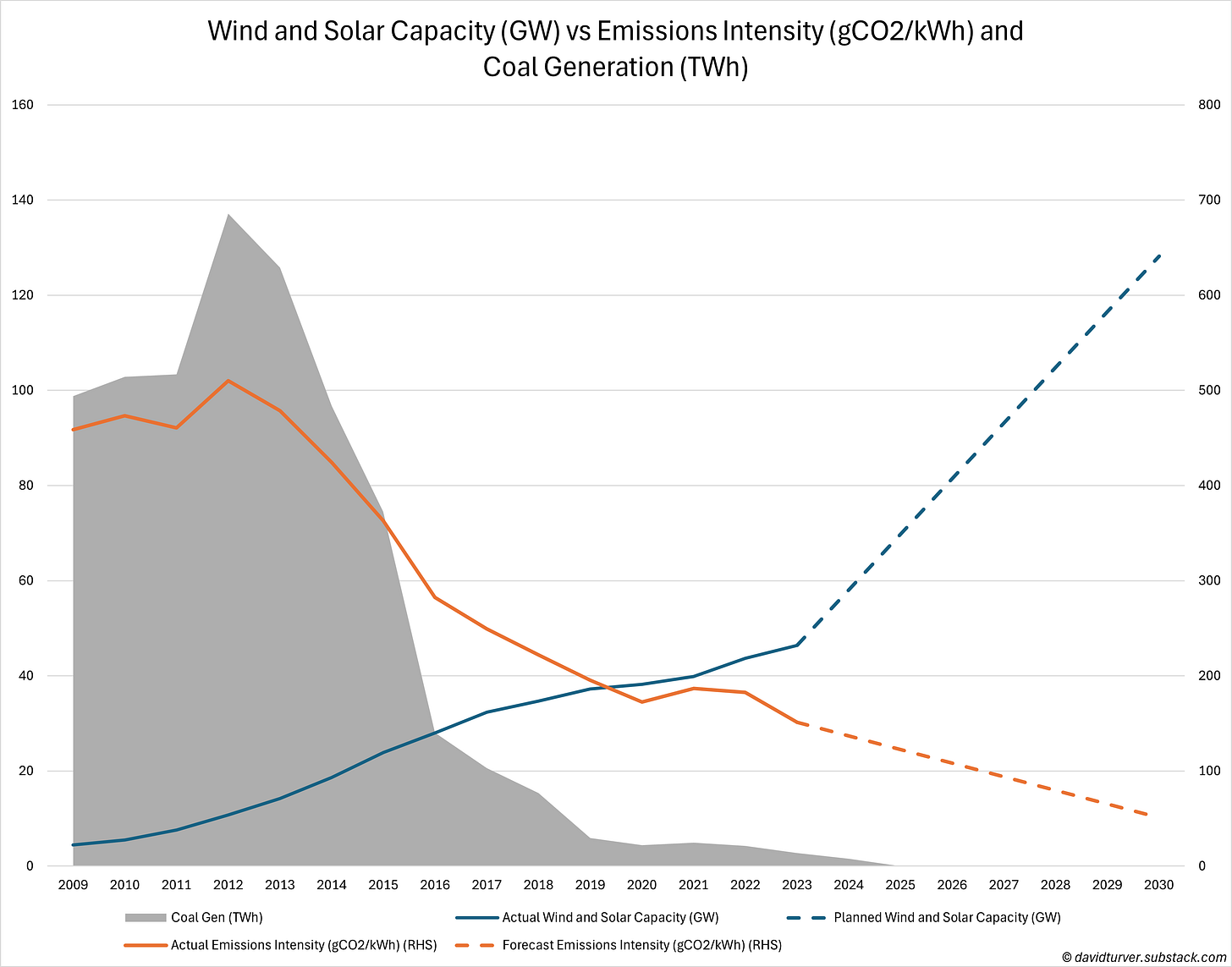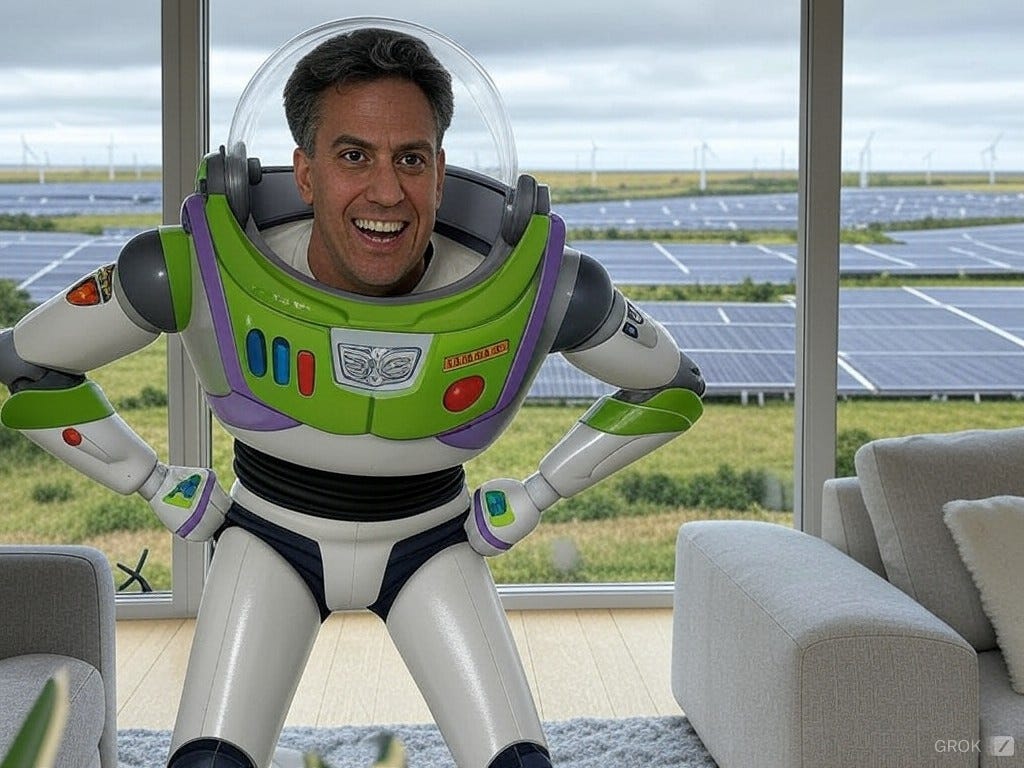To Infinity and Beyond
There is no limit to our electricity bills as new spending on renewables has diminishing impact on emissions intensity.
Introduction
I am grateful to a subscriber for drawing my attention to the trajectory of the emissions intensity of UK electricity generation compared to the scale of spending required to achieve Miliband’s Clean Power 2030 Action Plan.
As we shall see, each extra wind turbine and solar panel is delivering progressively less reduction in the amount of CO2 emitted by our electricity generation system, which implies that our bills are going to infinity and beyond.
Measurement of Emissions Intensity
The emissions intensity of electricity generation is measured in grammes of CO2 emitted per kilowatt hour of electricity. However, the measurement of emissions intensity is far from an exact science. I found three different datasets that all give slightly different results, although they all show broadly similar trends (see Figure 1).
First up, we have Ember who produce a chart and make their data available for download. They do not say where and how they source their data, but they show that emissions intensity has followed a lumpy path downwards after peaking in 2012 at 537g/kWh to about 228g/kWh in 2023. Second, we have the Government’s Digest of UK Energy Statistics (DUKES Table 5.14) which shows a similar path, but emissions intensity is consistently lower than Ember’s estimates, falling from 483g/kWh in 2012 to 171g/kWh in 2023. Finally we have NESO themselves who give half hourly readings for our electricity generation mix and emissions intensity on their dashboard. For this chart, I have created an annual weighted average of the NESO data. This follows a similar path to DUKES and Ember, with intensity falling from 519g/kWh in 2012 to 151g/kWh in 2023.
It is worth noting that part of this emissions reduction is achieved by sleight of hand. Emissions from burning wood chips at biomass plants like Drax are ignored, because they argue the trees will grow back over the coming decades. However, if stop pretending that burning trees produce no emissions and assume optimistically that it has a similar carbon intensity to that of coal, using the NESO data we can plot an adjusted emissions intensity including the biomass emissions (see Figure 2).
Already we can begin to see an emissions intensity con trick. Using the adjusted data, emissions intensity in 2023 becomes 202g/kWh, up 51g/kWh from the original data.
Emissions Intensity in the Clean Power 2030 Plan
If we move back now to the official NESO data, their emissions intensity for 2023 includes emissions from the “Other” category which includes Energy from Waste (EfW) and the emissions from Combined Heat and Power (CHP) plants.
The headline in NESO’s Clean Power Plan (Table 3) shows the emissions intensity falling to just 15g/kWh by 2030 (excluding BECCS and CCUS) in their “Further Flex” scenario. However, this figure is produced using another con trick. They explain that they arrive at this figure by excluding emissions from CHP and EfW. Their databook (Tab EC2) shows that if these emissions are added back, the emissions intensity goes back up to 51g/kWh. The Government action plan (Metric 2) claims that emissions intensity will fall to “well below” 50g/kWh by 2030.
For the purposes of the analysis below, we shall assume that NESO’s 51g/kWh in 2030 is a like-for-like comparison to their 151g/kWh in 2023.
Emissions Intensity vs Coal Generation
We can plot the path of emissions intensity versus the actual and NESO’s planned wind and solar capacity (see Figure 3). Coal-fired generation in TWh is added for illustrative purposes.

The solid blue line shows the actual wind and solar capacity and the dotted line shows the planned trajectory out to 2030. Note that the dotted line is much steeper than what has been achieved to date. The grey area is Coal Generation from the NESO dashboard. The solid orange line is NESO’s measurement of emissions intensity, with the dotted line extending to the 51g/kWh in 2030. Note that the rate of decline of the dotted line is much shallower than the period up to 2019 when most coal generation had been eliminated.
It is obvious that the vast bulk of emissions reduction up to about 2019 came from phasing out coal-fired generation. Emissions intensity as measured by NESO, peaked in 2012 alongside coal-fired generation at about 137TWh. Coal-fired generation fell into single digits in 2019 as emissions intensity fell 315g/kWh from 2012 levels to just 195g/kWh. During that time wind and solar capacity grew by 26.4GW from10.8GW to 37.2GW. Each extra GW of capacity led to a reduction in emissions intensity of 11.9g/kWh.
Since 2019, there has been much less coal on the system and consequently, extra emissions reductions have been harder to come by, even when the emissions from biomass are excluded. From 2019 to 2023, emissions intensity has fallen to 151g/kWh and a further 9.2GW of wind and solar capacity has been added. Each extra GW of wind and solar capacity led to a reduction in emissions intensity of just 4.8g/kWh.
This is not a surprising result because as we see in Figure 4, the minimum wind generation in each day since 2015 has barely changed, despite wind capacity more than doubling since then.
This chart reflects the mathematical truism that 1 x 0 = 0, 10 x 0 = 0 and 100 x 0 = 0. When there is no or very little wind, then no matter how many wind turbines we have, they will not be producing much electricity. We always need reliable, dispatchable power plants to provide backup, and with our current generation mix, this must be provided by gas. Even if they manage to get gas with carbon capture working at great expense, there will still be some emissions.
If we now turn to the plans for 2030, wind and solar capacity is scheduled to rise by 81.8GW to a total of 128.2GW and emissions intensity, on a like-for-like basis, is forecast to fall to 51.1g/kWh as discussed above. Each extra GW of wind and solar capacity will result in a measly 0.8g/kWh reduction in emissions intensity. We have entered a world of dramatically diminishing returns for each new pound of spending on renewables.
Electricity Prices to Infinity and Beyond
If we believe the Government and assume that the massive acceleration of wind and solar installation is achievable, we can speculate about what might happen to electricity prices. NESO said their plan would cost £44-48bn per year and the Government has rounded down their estimates to “around £40bn per year for the next 6 years.” The technical annex explains that the Government figures are rounded to the nearest £10bn and exclude financing costs and operations expenditure. If we take the NESO estimate of £48.4bn/year for six years, that is a total expenditure of £290.3bn. If we assume an 8% cost of capital and 2% operational costs, then we can expect our bills to rise by £29bn per annum by 2030, or the equivalent of more than £1,000 per household.
However, all this spending will only reduce emissions intensity to 51g/kWh. The extra spending on wind, solar and grid expansion will achieve much less emissions reduction than earlier spending. Looking beyond 2030, any further spending on wind, and solar will likely have an even smaller impact on emissions intensity per pound of spending. If the Government wants to achieve the true “zero-carbon electricity” promised in its manifesto, then our bills going to infinity and beyond.
This Substack is growing rapidly, now with well over 3,000 subscribers. This growing interest has led to me being invited to give a talk to Sacred Cows on 28th January in London entitled “Net Zero: Why the cure is worse than the climate change disease”. More details and ticket information can be found here, do come along if you can make it
If you enjoyed this article, please share it with your family, friends and colleagues and sign up to receive more content.








Thank you David! Your post seems to be another illustration of the law of diminishing returns. I feel that a pragmatic administration, while wishing to reduce carbon dioxide emissions, might have accepted that having achieved a useful reduction, a further drive to wind and solar would prove increasingly expensive and result in a grid that was progressively more unstable and hard to manage. Instead, we have an "at all costs" approach. The simple truth of intermittency is brushed aside: the unaffordable expenditure will crowd out better alternatives. I am hard pushed to recall similar ideological folly pursued by successive UK governments against such widespread ignorance and acquiescence.
Ah well, at least thanks to you and others I can see what's coming, though I fear only a full-blown crisis will make it apparent to the masses, followed by revolt.
The analysis appears to exclude interconnector imports. These are I believe officially deemed to be zero carbon. The fact that BritNed terminates right next door to the MPP3 coal and biomass co-fired power station is ignored. Biomass actually gives rise to more local CO2 emissions than coal. While the French interconnectors can reasonably be said to be supplied by the nuclear complex at Gravelines and in Normandy, it is increasingly unclear what the supply for the other interconnectors really is. Norwegian supply is likely to be from hydro, or perhaps from renwables surplus from Germany and Denmark on the occasions they are exporting. The origin of supply from Belgium is very unclear. In future, when NeuConnect opens we might find ourselves trying to cover Dunkelflaute with more coal generation in Germany.